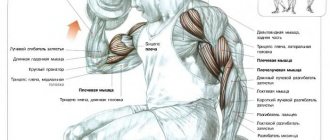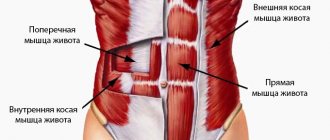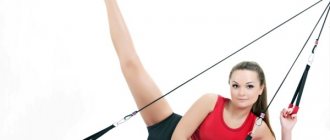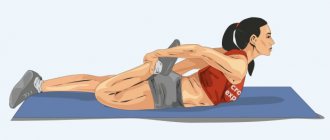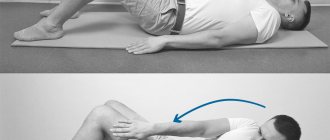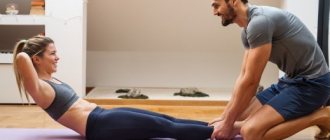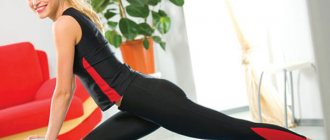Anatomy of the lateral abdominal muscles
The oblique abdominal muscles are located on the sides of the body. They are responsible for its rotation (turns), tilts and perform a stabilizing function, keeping the body level. Also, these muscles help hold the internal organs. If we want to have an even posture, then strengthening the obliques should be a must in your training. Two muscles in this area can be distinguished:
- External oblique. Forms the top layer of oblique muscles. It is this that forms the so-called lateral press. Its functions include twisting and bending of the body. It also gives us the opportunity to lean forward. And when lifting heavy weights, it stabilizes the spine.
- Internal oblique. It is located under the outer one. Due to the fact that it is attached to the lower part of the ribs, it lowers them during movement. With unilateral contraction, it turns the body in this direction. When two internal muscles contract at once, the body bends forward.
The external and internal muscles are constantly under tension when we stand. Allowing us to maintain an upright position.
Key Points Before Side Press Workout
It is very important to observe these points when training the lateral muscles. Since their development can affect the appearance of your waist.
Don't exercise on a full stomach
If you perform exercises for the oblique muscles on a full stomach, there may be unpleasant consequences. Such as dizziness or nausea. Therefore, you should wait 1-2 hours after eating. Giving the food time to digest. It is also not recommended to exercise on an empty stomach. After all, for a productive workout, the body needs energy. Where can you get it if there are no nutrients?
Before training you should stretch your muscles
Any physical activity is stressful for our body. And if you don’t warm up your muscles properly before training, you can easily get injured. To avoid this, you should perform a small WARM-UP complex. Particular attention should be paid to those muscles that will be most involved. In our case, these are oblique. For this, simple exercises such as bending and rotating the body are perfect.
It's not quantity that matters, but quality
Many people make one very fatal mistake. Namely, they perform abdominal crunches for a large number of repetitions. But they forget one very important detail. The oblique muscles are a muscle like any other. And for their development, 10 repetitions per set will be enough. The main thing is that when performing, we feel the muscle group that we are trying to load. So you should work on quality by developing neuromuscular connection. An exercise like VACUUM can help with this.
Excessive load
Although the abdominal muscles are very resilient. And it takes much less time to restore them. All the same, you should not overload them too much. Therefore, training the oblique muscles every day is a big mistake. Just 1-2 workouts per week is enough.
Eat right
No matter how hard we work on training our abdominal muscles, without proper nutrition we will not be able to evaluate the results of our labors. Since, due to the excess percentage of subcutaneous fat, they simply will not be visible. Therefore, it is worth reconsidering your diet if you want to create the body of your dreams. And at the same time have a narrow waist.
Workouts should be varied
The abdominal muscles are very fastidious. And they quickly get used to monotonous training. Therefore, they should be constantly surprised with new exercises. Luckily for the abs, there are a lot of them. At the same time, each exercise has the possibility of an easier version of it. So you don’t have to worry that you won’t be able to perform this or that element if you haven’t trained your oblique muscles before.
Stretching the muscles at the end of the workout
After a fruitful workout, you definitely need to stretch the working muscles. And the press is no exception. Stretching improves blood circulation. Calms the nervous system after hard work in the gym. Also, muscle pain will decrease and recovery will be much faster. So take 5 minutes at the end of your workout and reap the benefits.
How to pump up the oblique abdominal muscles: preparation
First, a few words about anatomy, for those who are just starting their sports journey and do not have any information. Remember that in the abdominal area we have:
- Rectus muscles - are a large group of muscles from the ribs to the pubis.
- Oblique muscles - there are internal and external. The internal oblique muscles cannot be seen. The external ones are responsible for the formation of the silhouette - they can be clearly seen on the bodies of professional bodybuilders - they “encircle” the waist from the sternum to the lower abdomen.
- Transverse muscles - run deep, directly under the rectus and oblique muscles, and represent a kind of belt around the waist.
We will definitely talk about how to work with the rectus and transverse muscles another time. The topic of our conversation today is how to pump up the oblique abdominal muscles. And in this matter one cannot do without careful preparation.
So, before moving on to exercises for the oblique abdominal muscles, you need to follow a few simple recommendations:
- The last meal is about a couple of hours before training. But working out on an empty stomach is also not the best solution. Ideally, have a snack two hours before your upcoming classes.
- Eating a large meal immediately after training is also not very healthy. It is worth waiting at least thirty minutes - and only after that have lunch. If you really can't stand it, snack on an apple or banana.
- Regardless of where you train - at home or in the gym - do not forget about warming up. This way you can activate blood circulation and prepare ligaments and muscles for the upcoming load. There are several warm-up options - run on the track, pedal on a bicycle, bend and twist your body. 5-10 minutes of warm-up - and you can start doing exercises for the oblique abdominal muscles.
So, how to pump up your oblique abdominal muscles? The main thing is to remember that during any exercise, muscle fibers are stretched and tense. If you don’t feel it, it means the exercise is being performed incorrectly. At the same time, you should know that during exercises the oblique abdominal muscles do not stretch very well, so they will quickly get tired. But don't panic - this reaction is normal.
Side Press Exercises
There is a wide range of exercises to work the oblique muscles. Of course, you shouldn’t use everything at once in one workout. Choose 3-4, when performed, you feel the oblique muscles working.
Side crunches lying on your side
This exercise is very easy to perform. Therefore, if you have never worked your abs, especially your oblique muscles, then it is best to start with lateral crunches. To perform it, no equipment is needed. It is enough to purchase a fitness mat to make it more comfortable to lie on the floor. This exercise allows you to work the oblique muscles in isolation. In this case, the load on the back muscles is minimal.
Performance:
- We will consider the exercise when performed on the right side.
- Place a fitness mat on the floor. Sit on it lying on your right side.
- Bend your knees to a right angle of 90°
- Extend your right hand and place it on your thigh.
- Bend your left arm at the elbow and place your palm on the back of your head.
- Exhale and begin to bend your right side, trying to bring your left elbow closer to your thigh.
- At the peak point, hold for 1-2 seconds, allowing the oblique muscles to work statically. And while inhaling, return to the starting position.
When performing, the main task is to feel how the oblique muscles work. Don't pull yourself with your hand towards your hip. Flexion occurs only due to contraction of the lateral abdominal muscles. You should not make sudden movements. We work at a medium or slow pace. We concentrate on contracting and stretching the muscles. It is possible to add weights when performing these crunches. But it's better not to do this. Since lifting weights can affect the appearance of your waist.
Russian twist
This exercise is more complex. And in addition to the lateral ones, it also loads the rectus abdominis muscle. But this does not make its effectiveness any less. It can be performed either without weight or using weights. To do this, use a dumbbell or a barbell disc. But, as mentioned earlier, you should not chase weight. The main task is concentrated work on the oblique muscles.
Performance:
- We sit on the floor. The legs are slightly bent at the knee joint, the feet are on the floor.
- The back is straight, the body is slightly laid back.
- The arms are bent and clasped in front of the chest.
- Before you begin. Secure your hips, pelvis and shoulders. Movement should occur only in the waist area.
- As you exhale, we turn to the left side, trying to contract the side muscles as much as possible.
- Then we begin to inhale and at the same time, turn to the right side. And at the end of the turn we exhale.
We try to turn not due to inertia. It is not the weight that controls the movement, but us through the contraction of the abdominal muscles. We work at an average pace. We try to feel the work of the oblique abdominal muscles. During rotation, the pelvis should remain in place. No movements are allowed in it. In order to complicate the exercise, you can not only use additional weights. Just lift your feet off the floor and lift them up. So oblique, you will still have to work in statics, acting as stabilizers.
Bicycle exercise with rotation
This exercise is classified as light. But in practice it turns out that not everyone can cope with it. Because we need to control several things at once. First, leg movement. They don't have to do all the work alone. Our main goal is to load the oblique and rectus abdominis muscles. Therefore, the legs should be adducted by contracting the abdominal muscles. Secondly, rotation. That is, along with the adduction of the leg, we must rotate in its direction with the opposite side. At the same time, maintaining control over the abdominal muscles. Third, body stabilization. If we do not control its position, the execution can turn into simple swinging. It is very important to control all these points. Or the exercise may not reach its full potential. And your time will be wasted.
Performance:
- Place a mat on the floor and lie on your back.
- Tighten your rectus abdominis muscle. To do this, pull in your stomach and slightly round your back.
- The buttocks should be pressed.
- Bend your arms and place your palms on the back of your head.
- The legs are straightened and the heels are on the floor.
- As you exhale, bend one of your legs and pull it towards your stomach. At the same time, we turn and pull the opposite shoulder towards the knee.
- At this time, the second leg remains straight and at the same time we keep it suspended.
- While inhaling, we return to the starting position.
- As you exhale, do the same on the other leg.
- We alternate sides like this the legal number of times.
There is no need to pull your head towards your leg with your hands. This can damage your neck. The movement occurs due to the work of the oblique muscles. We try to work at full amplitude. Ideally, you should try to touch your knee with your elbow. Movements should be slow and controlled. The pace is medium or slow. If this movement is difficult for you, you should start with a simpler option. To do this, we lie down on the floor. Bend your leg and place one on top of the other. And in the same way, we reach out with the opposite shoulder towards her.
Exercise "Pendulum"
The classic version of this exercise is performed while lying on the floor. It can be easily performed by athletes of any level of training. This exercise specifically loads the lateral abdominal muscles. What makes it as effective as possible. If, when performing, you feel discomfort in the lumbar region, then bend your legs at the knee joint.
Performance:
- We lie down on the floor. We place our arms to the sides, legs together.
- The pelvis, shoulder blades and lower back are pressed. We raise straight (or bent for back pain) legs up until they become perpendicular to the floor.
- As you exhale, we begin to lower our legs to one side until our feet touch the floor.
- Next, we inhale and return to the starting position, and repeat the same in the other direction.
Do not hurry. The movement should occur due to the work of the oblique muscles. If you want to make the exercise more difficult, then place the ball between your feet or hang from a horizontal bar. When performing the pendulum exercise, you don’t have to worry that your waist will become wide.
Exercise "Lumberjack"
This is a complex movement that allows you to work all the abdominal muscles with an emphasis on the obliques. In this case, the back and shoulders are involved in the exercise. They call it that because the movement resembles the work of a woodcutter cutting down a tree trunk with an ax. It can be performed with or without weight. The best thing for this purpose is a crossover exercise machine or a rubber expander.
Performance:
- Lift the crossover block to the very top. Install a rope or D-shaped handle.
- We stand sideways to the crossover. We grasp the handle with both hands. We place our feet shoulder-width apart. For greater stability, you can bend them slightly at the knees.
- As you exhale, rotate your body toward the opposite hip. At the same time, we lower our hands and pull the handle behind us.
- Pause briefly at the bottom. And while inhaling, return to the starting position.
You can also do the lumberjack exercise from the lower block. The execution will be almost the same, only in reverse order. We pull the handle from the hip to the opposite shoulder, while making a rotational movement in the body. If you do not have access to a crossover, then you can perform the exercise with a dumbbell. We just take it in our hands and do the same movements as described above.
Side plank
This exercise is very different from the previous ones. In it, we do not strain the abs isometrically (without movement). That is, we hold the maximum voltage in it for a certain amount of time. This will allow you to tighten your abdominal muscles and make your waist much smaller. You can perform this exercise both in the gym and at home.
Performance:
- We take the emphasis while lying down, as with the classic PLANK.
- Next, we turn to one side, transferring the weight to the forearm and foot, which rest on the floor.
- The free hand can be raised up, placed behind the head and extended along the body.
- The body should not sag, especially in the pelvic area.
- We strain our abdominal muscles and hold it in this position for 10-15 seconds.
- Afterwards, we move the body weight to the other forearm and repeat the same thing.
When performing the plank, do not hold your breath. Your entire body should remain aligned throughout the entire exercise. If it is difficult to stand in this position, you can simplify the exercise a little. To do this, bend your lower leg at the knee and rest it on the floor.
Training the side muscles will help improve your figure. Don't forget your abs are the showcase of your body. The central part, the development of which should come first. But for some reason in the modern world they devote the least time to it. We are not talking about everyday training. A few intense workouts per week are enough to see results. If you find exercises difficult, start with easier versions. Do the plank on your knees, the bicycle with your legs crossed, and so on. This way you can constantly progress and achieve great results.
Good luck to everyone in your training!
Similar articles:
How to pump up the oblique abdominal muscles for advanced athletes?
When the exercises from the previous block no longer seem difficult to you, you can safely move on to the advanced level. So, how to pump up the oblique muscles for more trained athletes:
- Starting - lying on the mat with straightened legs. One hand, bent at the elbow, should be placed behind the head, the other should lie on the stomach. Alternately bend your knees and pull your opposite elbows towards them. After the arm and leg meet, return to the starting position and repeat the movement in a mirror image - with the other arm and the other leg.
- The next exercise is similar to the previous one, only the legs are not extended, but are bent at the knees and standing on the mat. Both arms are bent at the elbows and placed behind the head. The goal is to lift your body and reach your elbow to the opposite knee, and then do the same with your other hand.
- Bent-overs with a bar are almost the same as with dumbbells from the previous block, only the equipment is a bar weighing 10.15 or 20 kilograms. Your feet should be shoulder-width apart and the handle of the bar should be placed on your trapezius. Slowly bend in different directions, trying to fix the lower position and feel the stretching of the muscles.
- The “Lumberjack” exercise is suitable for performing in the gym. Well, or at home, if you have a simulator with an upper block. It’s as easy as shelling pears to do: grab the handle with both hands and pull with chopping movements from your right shoulder to your left leg, and then vice versa.
Well, for a snack – a short training session in video format. A professional trainer will tell you how to pump up your oblique abdominal muscles and show you the most effective exercises.
Good luck!
